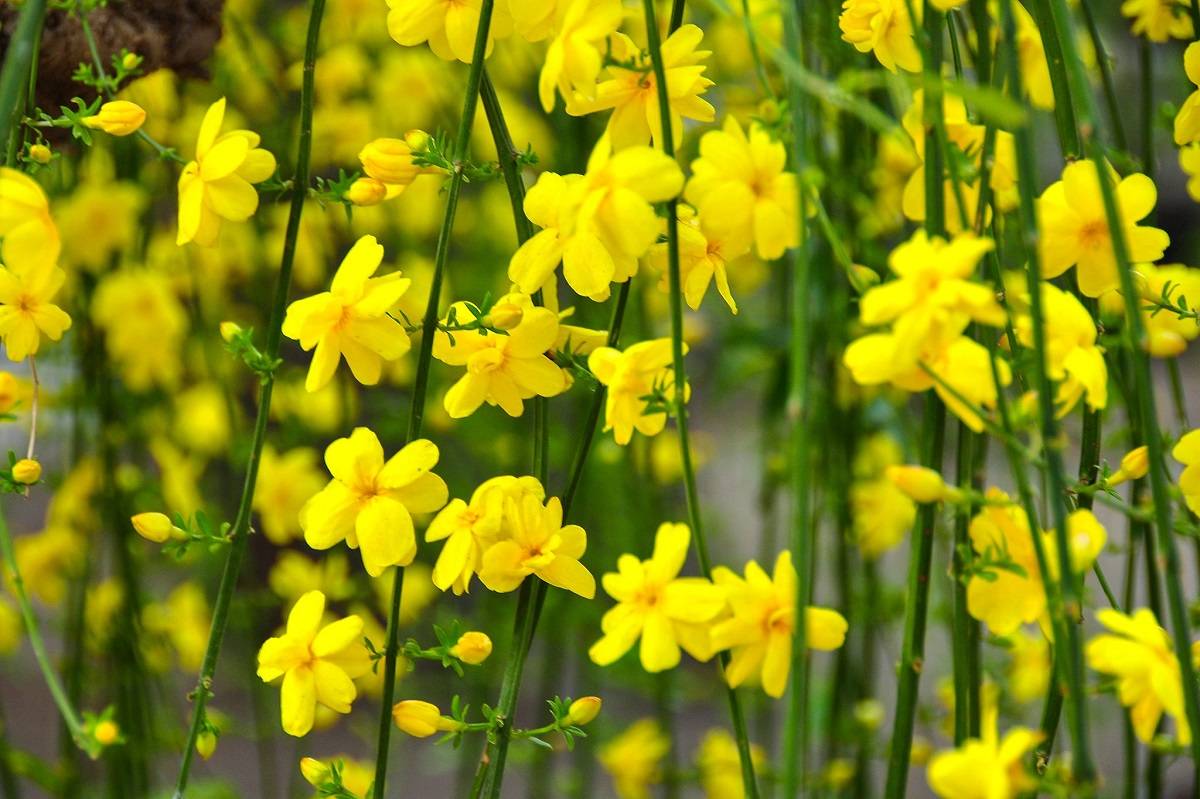
A deciduous plant with vivid yellow flower that bloom in late winter and early spring is called winter jasmine (Jasminum nudiflorum). These plants are a great option to invigorate a garden, especially during winter dormancy, because their star-shaped blooms can develop before the leaves.
The family Oleaceae, sometimes known as the olive family, also includes lilacs, forsythia, and winter jasmine. This cold-tolerant shrub, which comes originally from Northern China, has naturalized in North America and Europe and can be cultivated as a ground cover, a border plant, or as vines.
|
Botanical Name |
Jasminum nudiflorum |
|
Common Name |
Winter jasmine |
|
Plant Type |
Deciduous shrub |
|
Mature Size |
4 ft. tall, up to 15 ft. tall on a trellis |
|
Sun Exposure |
Full sun, partial shade |
|
Soil Type |
Chalk, loam, sand, clay |
|
Acid, alkaline, neutral |
|
|
Bloom Time |
Late winter |
|
Flower Color |
Yellow |
|
Hardiness Zones |
6-10 (USDA) |
|
Native Area |
China |
Growing Winter Jasmine
Winter jasmine plants feature dark green foliage and quickly-growing light green branches that are ideal for covering bare spots in your yard. To plant winter jasmine, follow these instructions:
1. Start the seeds to grow: Several months before it is warm enough to transplant to your garden, start growing indoors if you are beginning from seed. Before planting the seeds in potting soil, give them an overnight soak in water. Next, cover the seeds in plastic wrap and expose them to direct sunshine. Before bringing your winter jasmine outside, where its natural spreading may flourish, you can keep it inside as a houseplant for the first year.
2. In the early spring, plant outside: If starting from seeds, the plants will be prepared for transplanting after approximately four weeks, when they reach a height of around six inches. Winter jasmine may be planted outside in early spring or late fall. If you plant in the spring, you'll get the coveted late-winter bloom period.
3. Choose a location in your garden: Winter jasmine may be grown in USDA hardiness zones six through ten. Winter jasmine thrives in areas with some shade to full sun; brighter areas might result in rapid proliferation.
4. Plant in soil that drains properly: Rich, loamy, drainage-friendly soil is ideal for winter jasmine growth. Make sure the pot is about three inches larger and deeper than the root ball and add clay to help drainage if you're growing winter jasmine plants in containers.
5. Provide a trellis to support your plant: If it has the right structural support, winter jasmine may be a fantastic climber. You must give the arching branches of your winter jasmine a training framework, such as a trellis, wall, fence, or bigger tree, for it to develop as a vine as opposed to a shrub.
Care Instructions for Winter Jasmine
Winter jasmine is a low-maintenance plant that is hardy and robust. To obtain the most from your winter jasmine plants, bear the following advice in mind:
-
Don't water winter jasmine plants excessively. When the soil is dry, about twice each week, water your winter jasmine. In particular, during the plant's early growth stages, overwatering might harm the plant.
-
Include nutrition. Winter jasmine can tolerate some drought after it has grown. Compost may be a fantastic technique to increase the nutrients accessible to the plant, promoting healthy development. To keep weeds at bay, you may also spread mulch around the base of the plant.
-
Perform spring pruning. Winter jasmine should be pruned after it blooms to maintain a tidy appearance. The optimum time to prune is in the spring, and if you'd like, you may give your winter jasmine a rounded shape to make it into a wonderful, eye-catching border plant. To prevent winter jasmine from spreading, prune your plants many times.
-
Keep pests away from your plant. Although winter jasmine isn't very pest-prone, you may occasionally get rid of aphids or mealybugs on the plant by using insecticidal soap.











